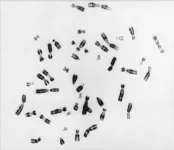(Press-News.org) CAMBRIDGE, MA – For people with paralysis or amputation, neuroprosthetic systems that artificially stimulate muscle contraction with electrical current can help them regain limb function. However, despite many years of research, this type of prosthesis is not widely used because it leads to rapid muscle fatigue and poor control.
MIT researchers have developed a new approach that they hope could someday offer better muscle control with less fatigue. Instead of using electricity to stimulate muscles, they used light. In a study in mice, the researchers showed that this optogenetic technique offers more precise muscle control, along with a dramatic decrease in fatigue.
“It turns out that by using light, through optogenetics, one can control muscle more naturally. In terms of clinical application, this type of interface could have very broad utility,” says Hugh Herr, a professor of media arts and sciences, co-director of the K. Lisa Yang Center for Bionics at MIT, and an associate member of MIT’s McGovern Institute for Brain Research.
Optogenetics is a method based on genetically engineering cells to express light-sensitive proteins, which allows researchers to control activity of those cells by exposing them to light. This approach is currently not feasible in humans, but Herr, MIT graduate student Guillermo Herrera-Arcos, and their colleagues at the K. Lisa Yang Center for Bionics are now working on ways to deliver light-sensitive proteins safely and effectively into human tissue.
Herr is the senior author of the study, which appears today in Science Robotics. Herrera-Arcos is the lead author of the paper.
Optogenetic control
For decades, researchers have been exploring the use of functional electrical stimulation (FES) to control muscles in the body. This method involves implanting electrodes that stimulate nerve fibers, causing a muscle to contract. However, this stimulation tends to activate the entire muscle at once, which is not the way that the human body naturally controls muscle contraction.
“Humans have this incredible control fidelity that is achieved by a natural recruitment of the muscle, where small motor units, then moderate-sized, then large motor units are recruited, in that order, as signal strength is increased,” Herr says. “With FES, when you artificially blast the muscle with electricity, the largest units are recruited first. So, as you increase signal, you get no force at the beginning, and then suddenly you get too much force.”
This large force not only makes it harder to achieve fine muscle control, it also wears out the muscle quickly, within five or 10 minutes.
The MIT team wanted to see if they could replace that entire interface with something different. Instead of electrodes, they decided to try controlling muscle contraction using optical molecular machines via optogenetics.
Using mice as an animal model, the researchers compared the amount of muscle force they could generate using the traditional FES approach with forces generated by their optogenetic method. For the optogenetic studies, they used mice that had already been genetically engineered to express a light-sensitive protein called channelrhodopsin-2. They implanted a small light source near the tibial nerve, which controls muscles of the lower leg.
The researchers measured muscle force as they gradually increased the amount of light stimulation, and found that, unlike FES stimulation, optogenetic control produced a steady, gradual increase in contraction of the muscle.
“As we change the optical stimulation that we deliver to the nerve, we can proportionally, in an almost linear way, control the force of the muscle. This is similar to how the signals from our brain control our muscles. Because of this, it becomes easier to control the muscle compared with electrical stimulation,” Herrera-Arcos says.
Fatigue resistance
Using data from those experiments, the researchers created a mathematical model of optogenetic muscle control. This model relates the amount of light going into the system to the output of the muscle (how much force is generated).
This mathematical model allowed the researchers to design a closed-loop controller. In this type of system, the controller delivers a stimulatory signal, and after the muscle contracts, a sensor can detect how much force the muscle is exerting. This information is sent back to the controller, which calculates if, and how much, the light stimulation needs to be adjusted to reach the desired force.
Using this type of control, the researchers found that muscles could be stimulated for more than an hour before fatiguing, while muscles became fatigued after only 15 minutes using FES stimulation.
One hurdle the researchers are now working to overcome is how to safely deliver light-sensitive proteins into human tissue. Several years ago, Herr’s lab reported that in rats, these proteins can trigger an immune response that inactivates the proteins and could also lead to muscle atrophy and cell death.
“A key objective of the K. Lisa Yang Center for Bionics is to solve that problem,” Herr says. “A multipronged effort is underway to design new light-sensitive proteins, and strategies to deliver them, without triggering an immune response.”
As additional steps toward reaching human patients, Herr’s lab is also working on new sensors that can be used to measure muscle force and length, as well as new ways to implant the light source. If successful, the researchers hope their strategy could benefit people who have experienced strokes, limb amputation, and spinal cord injuries, as well as others who have impaired ability to control their limbs.
“This could lead to a minimally invasive strategy that would change the game in terms of clinical care for persons suffering from limb pathology,” Herr says.
###
The research was funded by the K. Lisa Yang Center for Bionics at MIT.
END
MIT scientists learn how to control muscles with light
A new study suggests optogenetics can drive muscle contraction with greater control and less fatigue than electrical stimulation
2024-05-22
ELSE PRESS RELEASES FROM THIS DATE:
Smoking fentanyl, rising in SF, is a deadly new risk for overdose
2024-05-22
Now that smoking has replaced injecting as the most common way to consume fentanyl, UCSF researchers have uncovered an increased risk of fatal overdose from the residue that accumulates in smoking equipment.
The researchers found that people both shared fentanyl resin and consumed it accidentally. This may be increasing the risk of overdose, especially among those who use the equipment to smoke other drugs, like methamphetamine, and have not developed tolerance to opioids like fentanyl.
“The risk of overdose when sharing smoking devices with fentanyl resin could be seen as analogous to the risk of shared injection ...
3,500-year-old Mycenaean armor was suitable for extended battle - study
2024-05-22
A 3,500-year-old suit of Mycenaean armour may have been used in battle - and not just for ceremonial purposes as previously thought – new research reveals.
Researchers worked with a group of Greek military volunteers who wore a replica of the Dendra armour during extended simulations of the rigours of battle.
One of the best and most complete examples of Mycenaean-era full-body armour, the bronze panoply was discovered in a tomb in the Greek village of Dendra, by Greek and Swedish archaeologists in the 1960s. But since its discovery, the question has remained ...
Charité study in Nature: How cells deal with extra chromosomes
2024-05-22
Having extra chromosomes is typically an issue for an organism and can disrupt development or cause disease. But some cells benefit instead: For example, cancer cells or pathogenic yeasts can use extra chromosomes to escape treatment and become drug-resistant. A team of researchers from Charité – Universitätsmedizin Berlin has now deciphered how yeasts manage to compensate for the genetic imbalance. Their findings, published in the journal Nature,* could yield new approaches to dealing ...
SwRI highlights NEXTCAR II project innovations at 2024 ARPA-E Innovation Summit
2024-05-22
SAN ANTONIO — May 22, 2024 — Southwest Research Institute will share the latest developments from its ongoing NEXTCAR Phase II project at the 2024 ARPA-E Energy Innovation Summit in Dallas (May 22-24). The Institute’s NEXTCAR Program aims to reduce vehicular energy consumption by more than 30% using next generation connected and automated vehicle (CAV) technology.
“We are demonstrating real-world next-generation automated driving technology that puts SwRI’s ongoing NEXTCAR energy efficiency research into practice,” said SwRI’s Scott R. Hotz, P.E., director of the Powertrain ...
The role of three-dimensional power doppler for detecting ovarian cancer in adnexal masses
2024-05-22
Background and Aims
Three-dimensional power Doppler (3DPD) ultrasound has been used for assessing adnexal masses, and in this study, we aimed to perform a meta-analysis to evaluate its role in the differential diagnosis of adnexal masses.
Methods
A search for primary studies assessing the diagnostic performance of 3DPD in discriminating benign from malignant masses carried out between January 1990 and May 2023 was performed in Medline (PubMed), Scopus, and Web of Science databases with study quality evaluated ...
Sewage overflows linked to increase in gastrointestinal illnesses
2024-05-22
EMBARGOED UNTIL 12:01 a.m. EST Wednesday, May 22, 2024
Contact:
Jillian McKoy, jpmckoy@bu.edu
Michael Saunders, msaunder@bu.edu
##
During extreme rain or rapid snowmelt, the high volume of water that enters sewer systems can cause untreated sewage to flow into waterways in US cities that have combined wastewater and stormwater sewer systems, including the Merrimack River in Massachusetts.
A new study led by Boston University School of Public Health (BUSPH) researchers has found that residents living in the downstream communities that ...
Promethium bound: Rare earth element’s secrets exposed
2024-05-22
Scientists have uncovered the properties of a rare earth element that was first discovered 80 years ago at the very same laboratory, opening a new pathway for the exploration of elements critical in modern technology, from medicine to space travel.
Promethium was discovered in 1945 at Clinton Laboratories, now the Department of Energy’s Oak Ridge National Laboratory, and continues to be produced at ORNL in minute quantities. Some of its properties have remained elusive despite the rare earth element’s ...
New AI accurately predicts fly behavior
2024-05-22
We’ve been told, “The eyes are the window to the soul.” Well, windows work two ways. Our eyes are also our windows to the world. What we see and how we see it help determine how we move through the world. In other words, our vision helps guide our actions, including social behaviors. Now, a young Cold Spring Harbor Laboratory (CSHL) scientist has uncovered a major clue into how this works. He did it by building a special AI model of the common fruit fly brain.
CSHL Assistant Professor Benjamin Cowley and his team honed their AI model through a technique they developed called “knockout training.” ...
Study: Under extreme impacts, metals get stronger when heated
2024-05-22
Metals get softer when they are heated, which is how blacksmiths can form iron into complex shapes by heating it red hot. And anyone who compares a copper wire with a steel coat hanger will quickly discern that copper is much more pliable than steel.
But scientists at MIT have discovered that when metal is struck by an object moving at a super high velocity, the opposite happens: The hotter the metal, the stronger it is. Under those conditions, which put extreme stress on the metal, copper can actually be just ...
Firearm Homicide Demographics Before and After the COVID-19 Pandemic
2024-05-22
About The Study: In this study, death by firearm homicide was concentrated among Black individuals ages 15 to 24 before, during, and subsequent to the COVID-19 pandemic, implying that there are likely to be social and structural conditions that contribute to these racial disparities.
Corresponding Author: To contact the corresponding author, Alex R. Piquero, Ph.D., email axp1954@miami.edu.
To access the embargoed study: Visit our For The Media website at this link https://media.jamanetwork.com/
(doi:10.1001/jamanetworkopen.2024.12946)
Editor’s ...
LAST 30 PRESS RELEASES:
How does age affect recovery from spinal cord injury?
Novel AI tool offers prognosis for patients with head and neck cancer
Fathers’ microplastic exposure tied to their children’s metabolic problems
Research validates laboratory model for studying high-grade serous ovarian cancer
SIR 2026 delivers transformative breakthroughs in minimally invasive medicine to improve patient care
Stem Cell Reports most downloaded papers of 2025 highlight the breadth and impact of stem cell research
Oxford-led study estimates NHS spends around 3% of its primary and secondary care budget on the health impacts of heat and cold in England
A researcher’s long quest leads to a smart composite breakthrough
Urban wild bees act as “microbial sensors” of city health.
New study finds where you live affects recovery after a hip fracture
Forecasting the impact of fully automated vehicle adoption on US road traffic injuries
Alcohol-related hospitalizations from 2016 to 2022
Semaglutide and hospitalizations in patients with obesity and established cardiovascular disease
Researchers ‘listen in’ to embryo-mother interactions during implantation using a culture system replicating the womb lining
How changing your diet could help save the world
How to make AI truly scalable and reliable for real-time traffic assignment?
Beyond fragmented markets: A new framework for efficient and stable ride-pooling
Can shape priors make road perception more reliable for autonomous driving?
AI tracks nearly 100 years of aging research, revealing key trends and gaps
Innovative techniques enable Italy’s first imaging of individual trapped atoms
KIER successfully develops Korea-made “calibration thermoelectric module” for measuring thermoelectric device performance
Diversifying US Midwest farming for stability and resilience
Emphasizing immigrants’ deservingness shifts attitudes
Japanese eels, climate change, and river temperature
Pusan National University researchers discover faster, smarter heat treatment for lightweight magnesium metals
China’s 2024 Gastroenterology Report: marked progress in endoscopy quality and disease management
Pusan National University researchers uncover scalable method for ultrahigh-resolution quantum dot displays
Researchers use robotics to find potential new antibiotic among hundreds of metal complexes
Gut bacteria changes at the earliest stages of inflammatory bowel disease
Scientists develop new way to “listen in” on the brain’s hidden language
[Press-News.org] MIT scientists learn how to control muscles with lightA new study suggests optogenetics can drive muscle contraction with greater control and less fatigue than electrical stimulation






